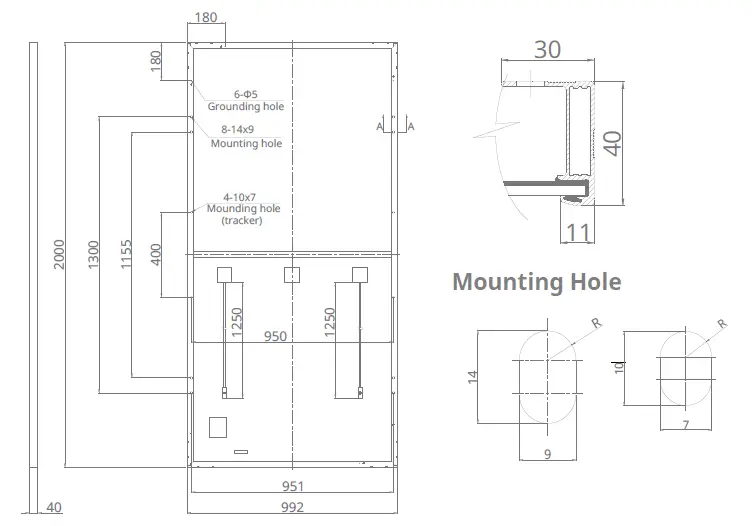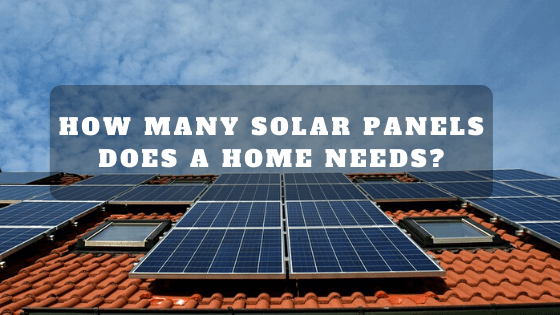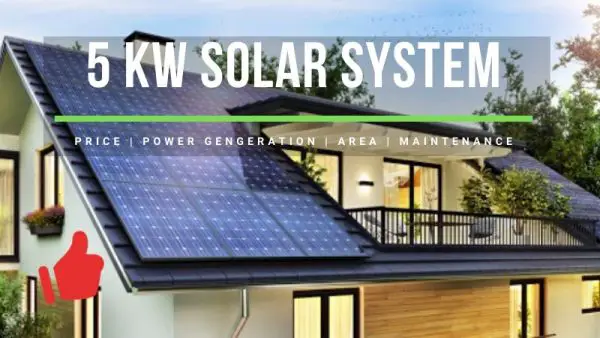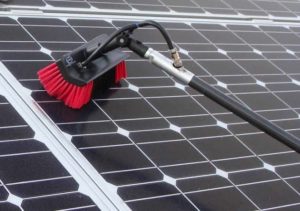If you are planning to install solar panels on your roof to reduce your electricity bill and want to know how many solar panels are needed to power your house then you have to right place.
I am working in the solar industry for the last two years and have helped many families adopt solar to reduce their electricity bill and I would love to help you as well.
On an average a house with monthly electricity consumption of 1000 kWh requires 26 – 30 solar panels (Each solar panel is of 320 watt).
To calculate the number of solar panels to completely offset your home electricity bill you need to divide your house monthly average power consumption by 120, this should give you the total kilowatt of solar panels needed for your house.
Then to calculate the number of solar panels just divide the kilowatt obtained in the above calculation by the wattage of one solar panel which you are planning to use. (Nowadays average wattage of most solar panels is above 300 watts).
For example, If your home consumes 1000 kWh of electricity in a month, and you are planning to use 320 watt solar panels then your house solar requirement is 1000 kWh / 120 kWh = 8.3 kW of solar panels.
Since you are using 320 watt solar panels, the total number of solar panels needed to power your house will be 8,300 watt / 320 watt = 26 solar panels.
How many solar panels does my house need?
To calculate the number of solar panels needed to power your house you need to know following two things.
- Average monthly power consumption of your house.
- Average monthly solar power generation at your place.
To find your average monthly power consumption of your house, just look into your latest month electricity bill, there you will find your last 12 months power consumption. Add the last 12 month power consumption data and divide it by 12 to get your house average monthly power consumption.
Once your get your house average power consumption it’s time to know your average monthly solar power generation. The average monthly solar power generation varies from 80 kWh to 130 kWh.
I live in Mumbai, India here we get at least 4 – 5 sun hours everyday for around 300 days in a year.
The average monthly power produced by a 1 kW solar system in Mumbai, India is around 110 kWh – 115 kWh. Let me clarify this value goes up in the summer and comes down in the rainy season so this is just an average value.
If your state or country receives similar amount of sun hours through out the year then you can assume your localities average monthly solar power generation to be 115 kWh.
Sun hours – A peak sun-hour, is an hour during which the intensity of sunlight is 1,000 watts per square meter. Peak sun hours is not same as ‘hours of sunlight’, you might get 6-8 hours of sunlight but your peak sun hours will be around 4.
In India sun hours varies from 3-5 hours, an average of 4 can be assumed for most places.
However if you live in cold countries or places where there is less sun hours then don’t take this value just google your countries name with monthly solar power generation in the suffix and you will get a figure for your monthly solar power generation.
If you don’t want to do that too, then take the average monthly solar power generation in your area to be 100 kWh.
Now that you know your house monthly power consumption and average monthly solar power generation, let’s calculate the number of solar panels needed to power your house.
Calculate Number Of Solar Panels Needed To Power A House?
To calculate the number of solar panels needed to power your house use the following steps.
- Calculate your average monthly power consumption.
- Divide your average monthly power consumption by average monthly solar power generation (115 kWh if you live in India) to get your solar panels requirement in kilowatt.
- Divide your kilowatt solar requirement by the wattage of one solar panel (Take one solar panel wattage to be 330 Watt as this is the most common solar panel used in 2020).
Lets say you live in Mumbai, India and you have calculated your house average monthly power consumption to be 900 kWh then how many solar panels will your house need? (assuming you use 220 watt solar panel) Lets calculate.
- Your house average monthly power consumption = 900 kWh.
- Your average monthly solar power generation = 115 kWh.(Since you live in India).
- Divide average monthly power consumption by average monthly power generation to get kilowatt of solar panels, 900 kWh / 115 kWh = 7.82 kW of solar panels.
- To calculate the number of solar panels, divide the 7.82 kilowatt of solar panels by individual solar panels wattage which is 330 watt in our case, 7,800 watt / 330 watt = 23.63, approximately 24 solar panels.
Now use the below calculator to find out the number of solar panels needed to power your house.
If your state or country receives similar amount of sun hours as India does then you can assume your average monthly solar power generation to be 110 kWh.
If you live in cold countries or places where there is less sun hours then don’t take this value just google your countries name with monthly solar power generation in the suffix and you will get a figure for your monthly solar power generation.
If you don’t want to do that too, then take the average monthly solar power generation in your area to be 100 kWh.
Factors Increasing number of solar panels for your house:
Even the most expensive solar panel in the world will not work in its full potential if not installed correctly. The generation of solar panels depend on the following factors:
- Shadow: The biggest enemy of solar panels is the shadow on the panels. Objects near by the solar panels like buildings, trees, poles all cast shadows on the solar panels which hamper the generation. So the solar panels should be placed in such a place where it receives at least 5 – 6 hours of shadow free sunlight everyday.
- Orientation: Ideally solar panels should be oriented towards the equator. So if you live in countries which fall in northern hemisphere like USA, Canada, India then your solar panels should be facing the south and if you like in countries which fall in southern hemisphere like New Zealand then your solar panels should be facing the north.
- Angle of inclination: The angle of inclination from the ground also plays an important role in power generation since the position of sun changes during summer and winter. So an angle should be chosen such that you can get the best generation throughout the year. If you have enough money to throw on some fancy tech then you can opt for the tracker system which follows the sun path and gives the maximum generation.
- Dust & snow: Even the best solar panel in the world will fizz out if there is a thick layer of snow or dust on it. Dust and snow prevents the sun rays from hitting the solar cells, since no sun rays are hitting the panels no electricity will be produced.
If after doing shadow analysis you found that your solar panels will get shadow free light only for 3 hours then you will have to oversize your solar system by adding extra 1 kW of solar panels.
Calculate area needed to install solar panels:

On an average the size of all the solar panels which are more than 300 watt is 2m x 1m (6.5 ft. x 3.25 ft.) which corresponds to an area of 2 sq.m or 21.50 sq.ft.
To calculate your total rooftop area requirement to install solar panels use the following equation.
Area required for solar panels = Total number of solar panels x area of one panel
In our above example for a 7.8 kW system we needed 24 solar panels which will need an area of,
Area for 7.8 kW of solar panels = 24 x 21.50 = 516 sq.ft
Mind you this is just the area required to mount all the solar panels back to back and side to side to each other. In real life you need to leave spaces between rows and columns of solar panels so that you can easily clean your solar panels every now and then, and also have safe access to perform any trouble shooting and maintenance.
Considering cleaning space and access for troubleshooting and maintenance of solar panels we can assume to install 1 kW of solar system on a metal roof you will need 85 sq.ft of shadow free area and to install 1 kW of solar system on a RCC terrace you will need 100 sq.ft of shadow free area.
The following table summarizes the area needed to install solar system.
| Solar System Size | No Of PV Panels (330 W Each) | Area Required |
|---|---|---|
| 1 kW Solar System | 3 | 65 sq.ft – 90 sq.ft |
| 2 kW Solar System | 6 | 145 sq.ft – 180 sq.ft |
| 3 kW Solar System | 9 | 205 sq.ft – 270 sq.ft |
| 5 kW Solar System | 12 | 285 sq.ft – 450 sq.ft |
| 8 kW Solar System | 25 | 580 sq.ft – 720 sq.ft |
| 10 kW Solar System | 30 | 750 sq.ft – 900 sq.ft |
The values on the left in the area column indicates the bare minimum area required to install solar panels (not considering space for cleaning & maintenance) and the values on the right indicates the minimum area required to install solar panels (considering space for cleaning & maintenance).
Cost of solar panels:
The price of solar panels depend on the wattage of solar panels, brand of solar panel, type of solar panel.
For most of the residential and industrial applications solar panels above 300 watts are used.
To give you a rough idea on solar panels pricing, on an average cost of polycrystalline solar panel above 300 watt is anywhere between Rs 20/watt to Rs 28/watt.
Whereas cost of monocrystalline solar panel above 300 watt is anywhere between Rs 32/watt to Rs 48/watt.
The following table summarizes the cost of 330 watts polycrystalline solar panels in India.
| Solar Panels Brand | Cost of Solar Panel (Rs / Watt) |
|---|---|
| Vikram Solar Panels | Rs 20 / Watt to Rs 25 / Watt |
| Waaree Solar Panels | Rs 19 / Watt to Rs 24 / Watt |
| Renewsys Solar Panels | Rs 19 / Watt to Rs 24 / Watt |
| Canadian Solar Panels | Rs 25 / Watt to Rs 30 / Watt |
| REC Solar Panels | Rs 25 / Watt to Rs 32 / Watt |
Note: The prices may go up and down depending on the availability in stock. The cost will also vary for bigger solar panels like 380 watt, 400 watt.
But only solar panels won’t help you to use that the generated electricity to power your appliance, you have to install a solar on grid system or a solar off grid system to produce electricity and make that electricity fit for household use.
Every year Ministry of new and renewable energy (MNRE) releases benchmark cost for installation of solar system in India. I have quoted MNRE benchmark cost for installation of solar on grid and off grid system in 2019 – 2020. You can download the actual PDF from here MNRE solar benchmark cost.
Cost Of Solar On Grid System:
In brief, solar on grid system is a grid tied system that allows you to use the solar energy when the sun is shining and supply the excess energy to the utility grid which you can pull at night when the sun is down and your solar is not generating electricity.
MNRE Benchmark Cost For Solar On Grid System in India:
| Solar System Size (kW) | Cost (Rs / kW) |
|---|---|
| Above 1 kW – 10 kW | Rs 60,000 / kW |
| Above 10 kW – 100 kW | Rs 55,000 / kW |
| Above 100 kW – 500 kW | Rs 53,000 / kW |
Note: The above pricing is benchmark cost set by MNRE, I work in the solar industry and have installed several solar on grid systems, the actual pricing goes up Rs 4,000/kW to Rs 10,000/kW for smaller systems (<20kW) and for larger system (>100kW) it generally comes down by Rs 2,000/kW to 5,000/kW. The prices totally depend on the quality of components you use.
To know more on pricing of solar on grid system read this article pricing of solar on grid system.
Cost of solar off grid system:
In brief, off grid solar system as the name suggests is a standalone solar system not connected to the electricity grid. In an off grid solar system the energy generated by solar panels is stored in the batteries, whenever there is power requirement the stored electricity is pulled from the batteries to power critical loads.
MNRE Benchmark Cost For Solar Off Grid System Upto 10 kW:
- 1 hour backup Rs 62,000/kW – Rs 68,000/kW.
- 3 hour backup Rs 74,000/kW – Rs 81,000/kW.
- 6 hour backup Rs 94,000/kW – Rs 1,03,000/kW.
MNRE Benchmark Cost For Solar Off Grid System Above 10 kW Upto 25 kW:
- 1 hour backup Rs 55,000/kW – Rs 60,000/kW.
- 3 hour backup Rs 66,000/kW – Rs 72,000/kW.
- 6 hour backup Rs 84,000/kW – Rs 92,000/kW.
Note: These are prices given by MNRE for a standard type of installation with standard equipment’s, if your solar panels installation has elevation, quality of equipment is top notch the prices will go up by Rs 5,000/kW –Rs10,000/kW.
To know more on pricing of off grid solar power system read this article pricing of solar off grid system.
Conclusion on Calculating solar panels requirement:
To calculate the number of solar panels needed for a home or a factory you need to first find out the average monthly consumption (kWh) of your house, then divide this by average monthly solar power generation in your area. This should give you the kilowatt of solar panels needed to power your house, then just divide that by the wattage of individual solar panels to get the total number of solar panels needed for your home.
In India, monthly power consumption of an average household is 250 kWh. Therefor an average Indian house needs approximately 2.3 kW of solar system which is 7 solar panels each of 330 watts.
If you liked this article and could successfully find your house solar panels requirement then please share this article with your friends.
If there are any doubts in your mind then let me know in the comments section.
Thank You 🙂
References:
- To know more about sun hours –http://wgbis.ces.iisc.ernet.in/energy/paper/hotspots_solar_potential/results.htm
- To calculate sun hours – https://www.solarpowerauthority.com/how-to-calculate-your-peak-sun-hours/
- To calculate ideal angle of inclination for solar panels – http://www.solarpaneltilt.com/
- https://mnre.gov.in/sites/default/files/schemes/Benchmark%20Order%20FY%202019-20.pdf






Hi,
i loved your explanation of solar system it was very well explained, but on a personal note can I discuss with you via email i need more advice on this subject.
This article was very helpful. Thank you very much!
In this you have covered on grid and off grid only. I am looking for a mix of these, where I want a solar battery backup during power outage, and the excess generated is sent/exported to the grid. Do we have a possibility of this one?
That’s pretty nice description. Now, I have a house that is yet to be constructed and I don’t know my average electricity consumption but I know that I will be running 3-4 fans, for almost all the time in summer, 8 20 watt tube lights for about 4 hrs, 1 geyser for about 2 hr in winters and some 3-4 10-12 watt LED bulbs in lawn for about 3 hrs all through the year. ACs won’t be there. And add a 50 inch TV running for say 8 hrs a day apart from charging my laptops, phones etc. how many solar panels I will need with no dependency on government supply?